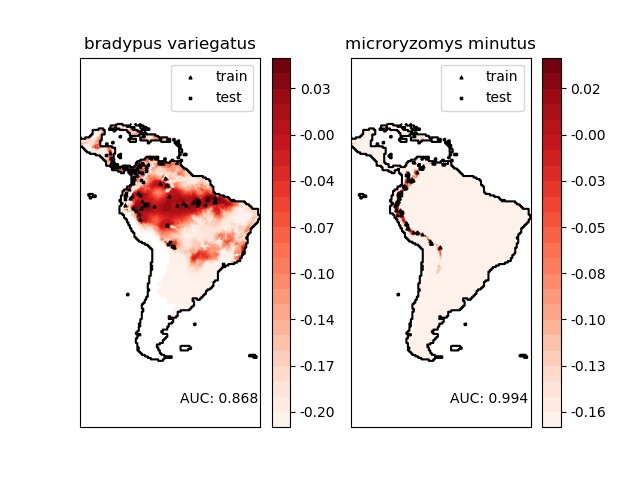新闻资讯
sklearn例程:OneClassSVM物种分布建模

物种分布建模示例简介
对物种的地理分布进行建模是保护生物学中的一个重要问题。在此示例中,根据过去的观察结果和14个环境变量,我们对两个南美哺乳动物的地理分布进行了建模。由于只有正例没有负例(没有不成功的观察结果),不方便做具有显示正负例的有监督机器学习,因此我们将此问题转化为密度估计问题,并使用由package sklearn.svm提供的OneClassSVM作为我们的建模工具。数据集来自Phillips et. al. (2006)。在这个示例中,我们使用basemap绘制出了南美的海岸线和国界。
示例中使用的2个物种是:
- “Bradypus variegatus”,褐喉树懒。
- “Microryzomys minutus”,也称为“森林小稻鼠”,一种啮齿动物,生活在秘鲁、哥伦比亚、厄瓜多尔、秘鲁和委内瑞拉。
参考文献
- “Maximum entropy modeling of species geographic distributions” (物种地理分布的最大熵建模)S.J. Phillips,R.P.Anderson,R.E.Schapire-Ecological Modelling,190:231-259,2006。
代码实现[Python]
# -*- coding: utf-8 -*- # Authors: Peter Prettenhofer # Jake Vanderplas # # License: BSD 3 clause from time import time import numpy as np import matplotlib.pyplot as plt from sklearn.datasets.base import Bunch from sklearn.datasets import fetch_species_distributions from sklearn.datasets.species_distributions import construct_grids from sklearn import svm, metrics # 如果basemap可用,则使用basemap绘制边界;否则自行处理实现。 try: from mpl_toolkits.basemap import Basemap
basemap = True except ImportError:
basemap = False print(__doc__) # 创建物种种群:基于物种名从训练集和测试集提取信息 def create_species_bunch(species_name, train, test, coverages, xgrid, ygrid): """Create a bunch with information about a particular organism
This will use the test/train record arrays to extract the
data specific to the given species name.
""" bunch = Bunch(name=' '.join(species_name.split("_")[:2]))
species_name = species_name.encode('ascii')
points = dict(test=test, train=train) for label, pts in points.items(): # choose points associated with the desired species pts = pts[pts['species'] == species_name]
bunch['pts_%s' % label] = pts # determine coverage values for each of the training & testing points ix = np.searchsorted(xgrid, pts['dd long'])
iy = np.searchsorted(ygrid, pts['dd lat'])
bunch['cov_%s' % label] = coverages[:, -iy, ix].T return bunch # 绘制种群分布 def plot_species_distribution(species=("bradypus_variegatus_0", "microryzomys_minutus_0")): """
Plot the species distribution.
""" if len(species) > 2:
print("Note: when more than two species are provided," " only the first two will be used")
t0 = time() # Load the compressed data data = fetch_species_distributions() # Set up the data grid xgrid, ygrid = construct_grids(data) # The grid in x,y coordinates X, Y = np.meshgrid(xgrid, ygrid[::-1]) # create a bunch for each species BV_bunch = create_species_bunch(species[0],
data.train, data.test,
data.coverages, xgrid, ygrid)
MM_bunch = create_species_bunch(species[1],
data.train, data.test,
data.coverages, xgrid, ygrid) # background points (grid coordinates) for evaluation np.random.seed(13)
background_points = np.c_[np.random.randint(low=0, high=data.Ny,
size=10000),
np.random.randint(low=0, high=data.Nx,
size=10000)].T # We'll make use of the fact that coverages[6] has measurements at all # land points. This will help us decide between land and water. land_reference = data.coverages[6] # Fit, predict, and plot for each species. for i, species in enumerate([BV_bunch, MM_bunch]):
print("_" * 80)
print("Modeling distribution of species '%s'" % species.name) # Standardize features mean = species.cov_train.mean(axis=0)
std = species.cov_train.std(axis=0)
train_cover_std = (species.cov_train - mean) / std # Fit OneClassSVM print(" - fit OneClassSVM ... ", end='')
clf = svm.OneClassSVM(nu=0.1, kernel="rbf", gamma=0.5)
clf.fit(train_cover_std)
print("done.") # Plot map of South America plt.subplot(1, 2, i + 1) if basemap:
print(" - plot coastlines using basemap")
m = Basemap(projection='cyl', llcrnrlat=Y.min(),
urcrnrlat=Y.max(), llcrnrlon=X.min(),
urcrnrlon=X.max(), resolution='c')
m.drawcoastlines()
m.drawcountries() else:
print(" - plot coastlines from coverage")
plt.contour(X, Y, land_reference,
levels=[-9998], colors="k",
linestyles="solid")
plt.xticks([])
plt.yticks([])
print(" - predict species distribution") # Predict species distribution using the training data Z = np.ones((data.Ny, data.Nx), dtype=np.float64) # We'll predict only for the land points. idx = np.where(land_reference > -9999)
coverages_land = data.coverages[:, idx[0], idx[1]].T
pred = clf.decision_function((coverages_land - mean) / std)
Z *= pred.min()
Z[idx[0], idx[1]] = pred
levels = np.linspace(Z.min(), Z.max(), 25)
Z[land_reference == -9999] = -9999 # plot contours of the prediction plt.contourf(X, Y, Z, levels=levels, cmap=plt.cm.Reds)
plt.colorbar(format='%.2f') # scatter training/testing points plt.scatter(species.pts_train['dd long'], species.pts_train['dd lat'],
s=2 ** 2, c='black',
marker='^', label='train')
plt.scatter(species.pts_test['dd long'], species.pts_test['dd lat'],
s=2 ** 2, c='black',
marker='x', label='test')
plt.legend()
plt.title(species.name)
plt.axis('equal') # Compute AUC with regards to background points pred_background = Z[background_points[0], background_points[1]]
pred_test = clf.decision_function((species.cov_test - mean) / std)
scores = np.r_[pred_test, pred_background]
y = np.r_[np.ones(pred_test.shape), np.zeros(pred_background.shape)]
fpr, tpr, thresholds = metrics.roc_curve(y, scores)
roc_auc = metrics.auc(fpr, tpr)
plt.text(-35, -70, "AUC: %.3f" % roc_auc, ha="right")
print("\n Area under the ROC curve : %f" % roc_auc)
print("\ntime elapsed: %.2fs" % (time() - t0))
plot_species_distribution()
plt.show()
代码执行
代码运行时间大约:0分20.185秒。
运行代码输出的文本内容如下,分别给出了2个物种的OneClassSVM建模AUC结果。
________________________________________________________________________________ Modeling distribution of species 'bradypus variegatus' - fit OneClassSVM ... done. - plot coastlines from coverage - predict species distribution Area under the ROC curve : 0.868443 ________________________________________________________________________________ Modeling distribution of species 'microryzomys minutus' - fit OneClassSVM ... done. - plot coastlines from coverage - predict species distribution Area under the ROC curve : 0.993919 time elapsed: 20.18s
运行代码输出的图片内容如下,图中2个物种的分布密度情况一目了然。

源码下载
- Python版源码文件: plot_species_distribution_modeling.py
- Jupyter Notebook版源码文件: plot_species_distribution_modeling.ipynb
回复列表







